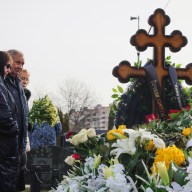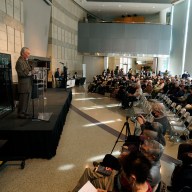MONTREAL – Entrepreneurs are using Canada’s most abundant winter resource — ice and snow — as the building blocks for a new cold-weather tourist attraction in Canada.
A new village opened this month in Montreal, with promoters hoping that an idea popular in Scandinavia might also catch on in this country.
Already a hit in Finland and Norway for the past decade, Snow Village is making its way across the Atlantic for the first time this winter.
It’s not only the first time the concept has been tried in North America — it’s also the first time such a “village” has been built just minutes from a major metropolitan area.
The European versions are in remote areas accessible by plane and they often involve an extended stay. Montreal’s village, by comparison, is accessible by public transit.
Guy Belanger says he fell in love with the concept after visiting Finland’s Lainio Snow Village, about 200 kilometres north of the Arctic Circle.
“We started working on the project a few years ago. We saw it first in Finland and fell in love with it,” said Belanger, one of the promoters behind the Montreal project.
“The whole concept is to build a village around the ice hotel, so what we’re doing here is we’re reproducing a city of the world every year around the hotel.”
For this inaugural year, that city is Montreal.
Replicas of local landmarks like Saint Joseph’s Oratory, the Olympic Stadium and the Montreal Museum of Fine Arts have been built out of ice and snow around the hotel.
Montreal’s winter wonderland village includes a 30-room ice hotel, a mix of standard rooms, suites and igloos. The hotel isn’t the first of its kind; there’s also an ice hotel just outside Quebec City.
The village looks like a collection of dome-like igloos from the outside, highlighted with blue lights on the sides and down the entrance hall. One of the first things people see when they go through the door to the village is a detailed ice sculpture of the Montreal skyline with such landmarks as Notre-Dame Basilica.
The long hallways connecting to the rooms are dotted with more red and blue lights and each room has a number that reinforces the winter theme, such as -5 and the really chilly sounding -30.
The structures, which are formed by packed snow blown onto frames which are later removed, have walls that are three metres thick.
Beds are comfy, but guests are equipped with warm sleeping bags for their sack time.
Some of the rooms have themes. One focused on hockey has an icy Stanley Cup and a sculpture of a Canadiens player. Hockey pucks are set into the footboard of the bed and a pair of seats from the old Montreal Forum complete the decor.
Other theme rooms nod to Montreal’s seasons and festivals.
There are inevitable comparisons between the site and Quebec City’s famous carnival, but Montreal is banking on the “village” aspect of the venture and also the fact that it lasts the whole winter.
“It’s a tourist attraction that’s not just for a week or two but for the entire season,” Belanger says.
A 60-seat ice restaurant with chairs and tables made of ice and overseen by well-known Montreal chef Eric Gonzalez, is open for lunch during the week and for dinner on Fridays and weekends.
Items on the menu include salmon and deer and a warm glass of wine.
Also on site is a 250-seat ice bar and patio where temperatures are always below zero.
Businesses and companies can book an ice conference centre, with a 200-person capacity, for meetings this winter.
There’s also a spot for so-called “white weddings,” allowing couples to exchange vows in the frozen chapel in what organizers dub a “fairy-tale like” setting, a replica of Montreal’s famous Oratory.
“White weddings is something that people are very interested in. That’s why we wanted to make sure it was part of the village,” Belanger said.
The village lacks little. There are outdoor spas for those looking to relax and, for younger visitors, a labyrinth and slides.
“The reservations have been very busy. We’re quite amazed and surprised by the response from the people in Montreal,” said Belanger.
Organizers hope to attract 80,000 people in their initial year.
At a cost of $2.1 million, supported partly by the Quebec government, the half-hectare village began welcoming visitors on Jan. 6 although the official opening was Jan. 18.
Entrepreneurs have signed on for four years at Parc Jean-Drapeau, near the site of Expo 67 and the city’s Formula One racetrack on a small island accessible by metro from Montreal.
“The view of Montreal you get from the site is really amazing,” Belanger said. “And the existing facilities allow us to accommodate people in a nice, natural space.”
The Nordic-inspired concept originates with Rami and Tomi Kurtakko, Finnish brothers who came up with the idea about a decade ago.
They came to Montreal to personally oversee the creation of the local version and remain involved in the project. What they’re hoping to do is create the first chain of ice hotels.
Even though it’s warmer in southern Quebec than in Scandanavia, they say the buildings are safe. There are even functioning fire alarms embedded in the snow walls, as mandated by the city.
“We’ve done this for 10 years in Finland without having any problems with safety,” Rami Kurtakko said recently, as he supervised the building process. “These structures have been calculated according to local authorities and engineers.”
While winter weather is a key marketing tool for getting people out to see the Snow Village, it’s not integral to creating it.
Belanger says workers are using low-pressure cannons to produce snow at night, when temperatures drop.
Yes, they’re using synthetic white stuff — even in Canada.
“We cannot use snow that falls from the air. We have to use the snow from the cannons because the density is much better,” Belanger said.
———
If You Go …
— Snow Village is located at Parc Jean-Drapeau, a few minutes walk from the Parc Jean Drapeau Metro station. It will be open from Jan. 6 to March 31. Adult admission is $13 on weekdays and $17 on weekends. There are also children’s and family rates.
— A standard room in the ice hotel starts at $259 per person, which includes use of a thermal sleeping bag. A night in a “polar igloo” goes for $195.
— Couples seeking a “wedding in white” can book the chapel for a package that includes arrival in a horse-drawn sleigh and overnight in a suite at the hotel.
— For more information or to make a reservation, call 514-788-2181 or toll-free 1-855-788-2181 or visit http://www.villagedesneiges.com or http://www.snowvillagecanada.com
———
— With files from Nelson Wyatt in Montreal.















